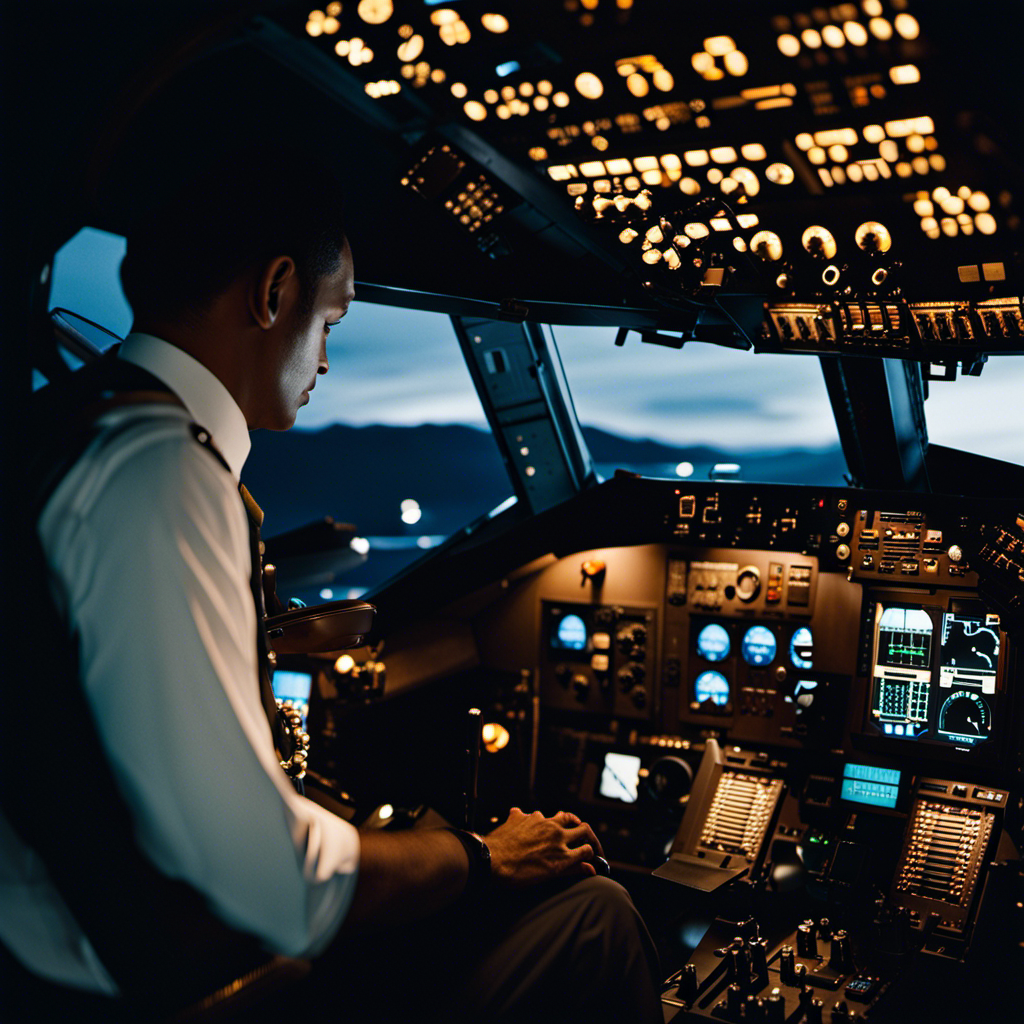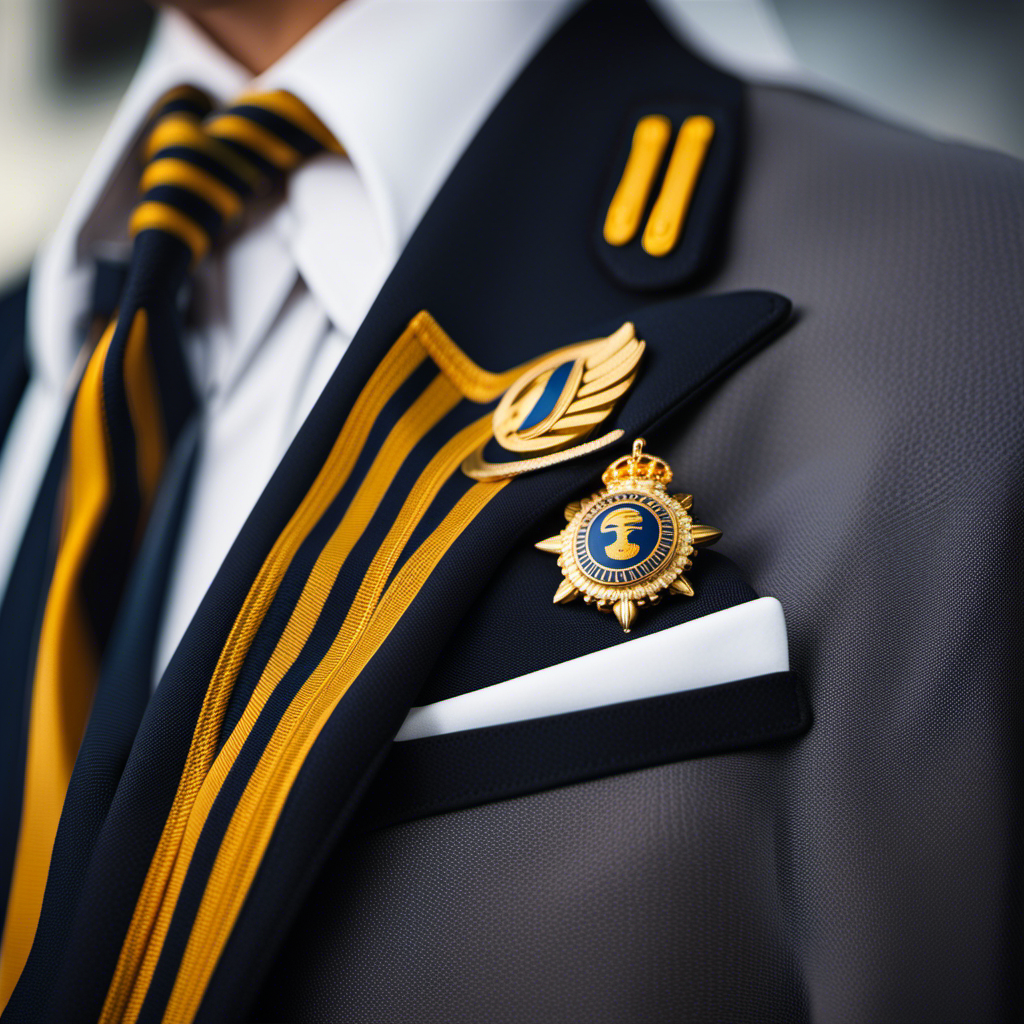Pilots are known to consider the clouds their second home. But what happens when exhaustion sets in and the need for sleep becomes inevitable?
In this article, I delve into the alarming reality of how many pilots have fallen asleep while flying.
Through a meticulous exploration of pilot fatigue, statistics, and strategies for prevention, we will uncover the importance of pilot alertness and the role technology plays in ensuring our safety in the skies.
So buckle up as we navigate this critical issue together.
Key Takeaways
- Notable fatigue-related accidents and near-misses highlight the dangers of pilot fatigue and the importance of pilot rest.
- The aviation industry has implemented safety improvements such as enhanced training, stricter regulations, and fatigue risk assessment tools.
- Ongoing research on pilot fatigue and the development of innovative fatigue monitoring systems are expected to contribute to future prevention measures.
- Passengers have varying experiences and safety concerns related to pilot fatigue, emphasizing the need for well-rested and capable pilots in the cockpit.
Understanding Pilot Fatigue
You need to understand the importance of managing pilot fatigue to prevent incidents like falling asleep while flying.
Pilot fatigue research has shown that sleep deprivation can have serious effects on a pilot’s performance. Lack of sleep can impair cognitive functions, such as attention, decision-making, and reaction time. It can also lead to decreased vigilance and increased errors.
Studies have found that fatigue can have similar effects on pilots as alcohol intoxication. This means that a fatigued pilot may have impaired judgment and coordination, similar to someone who is drunk.
Understanding the impact of sleep deprivation on pilots is crucial in order to implement effective strategies to manage and mitigate fatigue. By prioritizing pilot alertness, we can ensure safer skies and prevent accidents caused by fatigue-related factors.
The Importance of Pilot Alertness
Ensuring pilot alertness is crucial during flights. Pilot sleep deprivation and fatigue can have a significant impact on decision making. It is vital for pilots to be well-rested and mentally sharp in order to make quick and accurate judgments while in the air. When pilots are sleep deprived, their ability to process information, react to emergencies, and make sound decisions is compromised. To illustrate the importance of pilot alertness, consider the following table:
| Pilot Alertness | Impact on Decision Making |
|---|---|
| Well-rested | Clear thinking |
| Sleep deprived | Impaired judgment |
| Fatigued | Slower reaction time |
| Exhausted | Increased risk of errors |
As shown in the table, the level of pilot alertness directly affects their decision making abilities. Transitioning into the next section, let’s explore the statistics on pilot fatigue, providing a deeper understanding of this critical issue.
Statistics on Pilot Fatigue
Statistics show that pilot fatigue is a widespread issue in the aviation industry. Underreporting of fatigue-related incidents makes it difficult to accurately quantify the extent of the problem. However, studies have indicated that pilot fatigue has a significant impact on decision-making abilities, compromising flight safety.
The following statistics paint a concerning picture:
- In a survey conducted by the National Sleep Foundation, 20% of pilots admitted to making significant errors due to fatigue.
- Another study found that pilots who reported being fatigued were twice as likely to have made a serious operational error during flight.
- A report by the Federal Aviation Administration (FAA) revealed that 13% of pilots surveyed had fallen asleep during a flight.
These statistics highlight the gravity of the issue and emphasize the urgent need for effective measures to prevent fatigue-related incidents. By understanding the impact of pilot fatigue on decision-making, we can explore the role of technology in mitigating these risks.
The Role of Technology in Preventing Fatigue-Related Incidents
With advancements in technology, there are now innovative solutions available to help combat fatigue-related incidents in the aviation industry. The role of technology in preventing fatigue-related incidents is crucial.
One such technology is the fatigue monitoring system, which uses sensors to detect the pilot’s fatigue levels by analyzing their physiological data. This system alerts the pilot and the airline if fatigue is detected, allowing necessary intervention to prevent any potential accidents.
Additionally, the use of automation in aircrafts has reduced the workload on pilots, minimizing fatigue and the risk of errors. Advanced scheduling software also plays a vital role in managing pilot fatigue by optimizing duty schedules and ensuring adequate rest periods.
These technological advancements have significantly contributed to enhancing safety in the aviation industry.
Transitioning to the subsequent section, let’s explore airlines’ strategies for managing pilot fatigue.
Airlines’ Strategies for Managing Pilot Fatigue
Airlines employ various strategies to effectively manage pilot fatigue. These strategies are designed to ensure that pilots are well-rested and able to perform their duties safely. One key aspect of pilot fatigue management is the implementation of airline policies on pilot rest. These policies outline the minimum rest requirements for pilots between flights and the maximum number of hours they can work in a given period. To give you an idea of how these policies work, here is a table showcasing the rest requirements for pilots in a major airline:
| Rest Period | Duty Period Limit |
|---|---|
| 10 hours | 8 hours |
| 12 hours | 10 hours |
| 14 hours | 12 hours |
| 16 hours | 14 hours |
| 18 hours | 16 hours |
These policies help ensure that pilots have adequate time to rest and recover between flights, minimizing the risk of fatigue-related incidents. However, pilot advocacy for improved rest and sleep continues to be an important topic in the industry.
Pilot Advocacy for Improved Rest and Sleep
In order to address the issue of pilot fatigue, airlines have implemented various strategies. However, it is crucial to recognize that pilot well-being is not just a matter to be managed by airlines alone.
Pilots themselves have been advocating for improved rest and sleep in order to mitigate the detrimental effects of sleep deprivation. Recognizing the importance of their own well-being, pilots have been actively engaging in discussions and pushing for better scheduling practices and rest facilities.
They understand that sleep deprivation can impair their cognitive abilities, reaction times, and decision-making skills, all of which are critical during flight operations. By advocating for improved rest and sleep, pilots are not only prioritizing their own safety, but also that of their passengers and crew members.
This proactive approach towards their well-being plays a crucial role in preventing fatigue-related incidents. Speaking of which, let’s examine some case studies that highlight the consequences of pilot fatigue.
Case Studies of Fatigue-Related Incidents
In this discussion, I’ll be exploring the subtopic of notable fatigue-related accidents and near-misses, as well as the lessons learned and safety improvements implemented as a result.
It’s important to examine these incidents to understand the potential consequences of fatigue in various industries and to identify effective strategies for mitigating its risks.
Through a detailed analysis of these case studies, we can gain valuable insights into the impact of fatigue on safety and explore the measures taken to prevent future incidents.
Notable Fatigue-Related Accidents and Near-Misses
Did you know about the notable fatigue-related accidents and near-misses experienced by pilots who’ve fallen asleep while flying? These incidents highlight the critical importance of pilot rest and the potential dangers of sleep deprivation.
One such incident occurred in 2008 when a passenger aircraft overshot its destination by 150 miles because both pilots had fallen asleep. In 2013, a cargo plane crashed just short of the runway, killing both pilots, due to fatigue-related impairment. These accidents serve as stark reminders of the devastating consequences that can result from pilot fatigue.
As a result, the aviation industry has implemented various safety improvements. These include revised duty time regulations and increased awareness and training on the importance of sleep and fatigue management.
Lessons Learned and Safety Improvements Implemented
After analyzing the notable fatigue-related accidents and near-misses, important lessons have been learned, leading to significant safety improvements in the aviation industry. These improvements have focused on understanding pilot performance and implementing fatigue risk management.
-
Enhanced Training: Pilots are now receiving specialized training on recognizing and mitigating the effects of fatigue on their performance.
-
Regulatory Changes: Aviation authorities have implemented stricter regulations regarding duty and rest periods for pilots, ensuring they have sufficient time to recover between flights.
-
Fatigue Risk Assessment: Airlines are now utilizing comprehensive fatigue risk assessment tools to identify potential fatigue-related risks and take proactive measures to mitigate them.
-
Technology Advancements: The development of fatigue monitoring systems and wearable devices has enabled real-time monitoring of pilots’ fatigue levels, allowing for immediate intervention if necessary.
These initiatives have greatly enhanced safety in the aviation industry and have paved the way for the future of pilot fatigue prevention.
The Future of Pilot Fatigue Prevention
You can expect advancements in technology and regulations to address pilot fatigue prevention in the future.
Pilot fatigue research is ongoing, with experts continuously studying the causes and consequences of fatigue in pilots. These studies aim to identify effective strategies for mitigating fatigue and improving pilots’ alertness during flights.
In the future, we can anticipate the implementation of innovative fatigue monitoring systems that track pilots’ fatigue levels in real-time. These systems could provide timely alerts and interventions to prevent exhaustion-related incidents.
Additionally, regulations may be further strengthened to ensure that airlines prioritize pilot rest and establish adequate schedules that promote alertness.
By combining research findings, technological advancements, and regulatory measures, the aviation industry is striving to create a safer environment for pilots and passengers alike.
As we explore passengers’ perspectives on pilot fatigue, it becomes evident that their trust and confidence in the industry heavily rely on the assurance of well-rested and alert pilots.
Passengers’ Perspectives on Pilot Fatigue
As we explore the future of pilot fatigue prevention, it is crucial to consider the passengers’ perspectives on this issue. Passengers have varied experiences when it comes to flying and safety concerns related to pilot fatigue. Some may not even be aware of the potential risks associated with tired pilots, while others may have heard stories or had personal encounters that raised their concerns.
Passengers want to feel confident and secure during their flights, knowing that the pilots in the cockpit are well-rested and fully capable of handling any situation that may arise. By addressing pilot fatigue and implementing effective prevention measures, airlines can not only enhance passenger experiences but also alleviate safety concerns, ensuring that every flight is a safe and comfortable journey for all.
Transitioning to the conclusion and call to action: It is evident that pilot fatigue is a critical issue that requires immediate attention and action.
Conclusion and Call to Action
It’s clear that addressing pilot fatigue is crucial and immediate action is needed. Pilot fatigue management is essential to ensure the safety of both pilots and passengers. Raising awareness about this issue is paramount, as it affects the lives of everyone who boards an aircraft.
To paint a vivid picture of the importance of pilot fatigue management, consider the following:
- A pilot struggling to keep their eyes open, fighting against exhaustion.
- The sound of a loud alarm, alerting the pilot that they are drifting off to sleep.
- The tension in the cockpit as the co-pilot takes over control to prevent a disaster.
- The relief felt by passengers upon landing, unaware of the near-miss they narrowly avoided.
- The potential tragedy that could occur if pilot fatigue is not properly addressed.
Frequently Asked Questions
What are the specific regulations and guidelines for pilot rest and sleep?
The regulations and guidelines for pilot rest and sleep are well-established. They ensure that pilots have sufficient rest periods between flights and set limits on the number of hours they can fly in a given period. These measures prioritize safety and prevent fatigue-related incidents.
How do pilots manage their sleep schedules when they have irregular working hours?
Pilot fatigue management is crucial for safe flying. Sleep strategies for pilots include maintaining a consistent sleep schedule, ensuring adequate rest before flights, and utilizing naps during long breaks.
Are there any specific training programs or courses available for pilots to learn about fatigue management?
Yes, there are fatigue management courses available for pilots to learn about managing their rest and fatigue. These courses help pilots understand pilot rest regulations and implement strategies to mitigate the risk of fatigue-related incidents.
What are the potential consequences of pilot fatigue on flight safety?
Pilot fatigue can have catastrophic consequences on flight safety. Sleep deprivation impairs decision making, compromising the pilot’s ability to react effectively in critical situations. The potential for disaster looms when fatigue sets in.
How do pilots communicate their fatigue levels to their airlines or aviation authorities?
Pilot fatigue reporting is crucial for aviation safety. Airlines and aviation authorities use fatigue monitoring systems, such as self-reporting tools and fatigue risk management programs, to track and address pilot fatigue levels.
Conclusion
In conclusion, it is crucial to address the issue of pilot fatigue to ensure the safety of both pilots and passengers. The statistics on pilot fatigue incidents are alarming, with numerous cases of pilots falling asleep while flying.
However, airlines are implementing strategies and utilizing technology to prevent such incidents. It is essential for passengers to be aware of the efforts being made to combat pilot fatigue and to support these initiatives.
By working together, we can create a safer and more secure environment in the skies.








